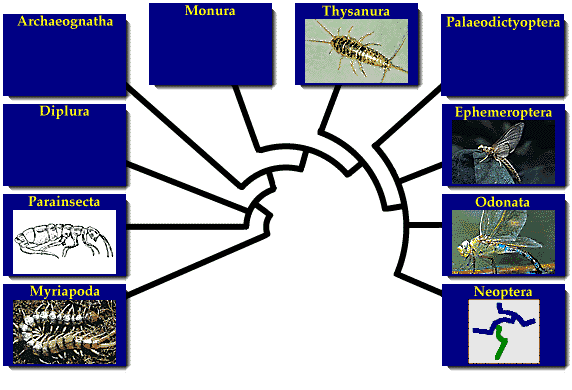



Uniramia: Systematics, Part 1






It isn't easy to condense the diversity of over three-fourths of the world's animals into a few pages, but we went ahead and did it. This phylogeny has been generally accepted for the past fifteen years, and so we use it here.
Where are the insects on this page? Insects are distinguished by having a body divided into head, thorax, and abdomen, with 11 segments on the abdomen, and three pairs of appendages on the thorax. Thus the Myriapoda, the centipedes, millipedes, and their kin, are not insects; they have many more appendages, and their bodies are not divided into thorax and abdomen.
Neither are the Parainsecta (springtails and proturans) or Diplura (diplurans) true insects, for their numbers of abdominal segments vary. These two clades, together with the true insects, form the clade Hexapoda ("six-legged"). The Insecta include all clades clockwise from the Archaeognatha (jumping bristletails); thus it also includes the Thysanura (silverfish or firebrats), Ephemeroptera (mayflies), Odonatoida (dragonflies and damselflies), and the many insect orders in the Neoptera, as well as other groups known only from fossils.
Keep watching this page as we get more information on-line.
Drawings and information about a wide range of uniramians, mostly insects, are available from the University of Illinois Department of Entomology. We have used some of them in this exhibit; our thanks to David Lampe for making them available to us. We also recommend the University of Delaware Insect Database for excellent brief synopses of the major insect orders.
Also, check out the arthropod portion of the Tree of Life at the University of Arizona.

Carpenter, F. M. 1992. Treatise on Invertebrate Paleontology. Part R. Arthropoda 4, Volume 3: Superclass Hexapoda. Geological Society of America and University of Kansas, Boulder, Colorado and Lawrence, Kansas.

